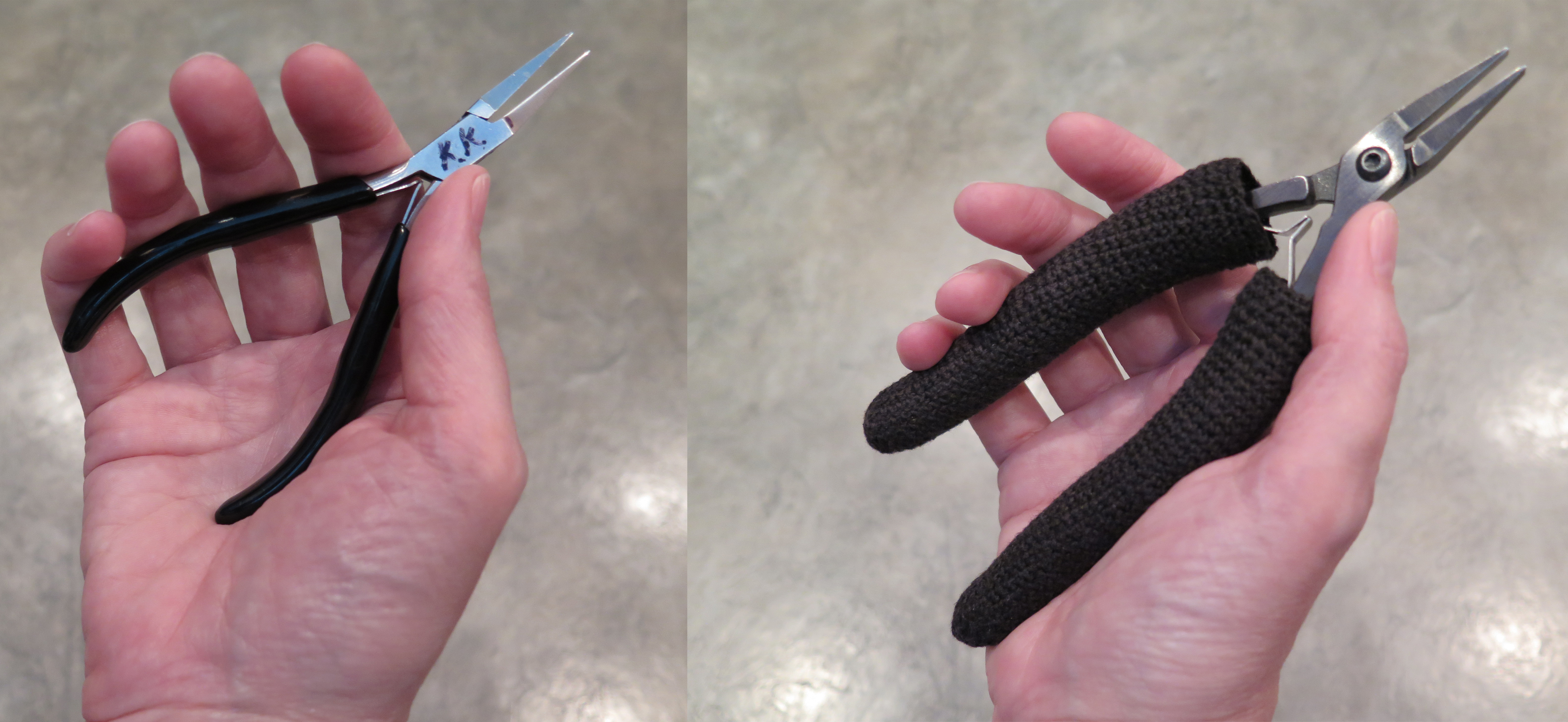What to Consider When Choosing Pliers (Part 4 of 4)
In the previous installment of this blog, I discussed different types of spring mechanisms. Handles are also an important consideration. When weaving maille, the pliers are in your hands for long periods of time, so you want to make sure that they are comfortable.
HANDLES:
When choosing pliers, I look at plier handle length, width, shape, weight and feel. It is best if you can actually hold them before you buy them. When purchasing on-line, study the photos and read the descriptions carefully.

Although I am a small person with small hands, I prefer long handled pliers. Short handled pliers tend to rest in the center of my palm (above, left), creating a sore spot. Longer handles distribute the pressure more evenly along the length of the handle (above, right).
 Again, even though I have small hands, I prefer thicker handles. Thin handles can concentrate the handle pressure causing soreness. Thin handles can be wrapped or covered to increase comfort. I have purchased cushioned handle grips (visible in some photos) and have also augmented thin handles using thermoplastic products (above, right) like Aquaplast or Jett Sett.
Again, even though I have small hands, I prefer thicker handles. Thin handles can concentrate the handle pressure causing soreness. Thin handles can be wrapped or covered to increase comfort. I have purchased cushioned handle grips (visible in some photos) and have also augmented thin handles using thermoplastic products (above, right) like Aquaplast or Jett Sett.
 Because of my small hands, I prefer handles that have a straight profile, like the Lindstroms pictured above, left. Pliers that have handles that bow out (above, right), are a little large for me to hold on to, and therefore cause my hands to tire more quickly. People with large hands might prefer a fuller shaped handle.
Because of my small hands, I prefer handles that have a straight profile, like the Lindstroms pictured above, left. Pliers that have handles that bow out (above, right), are a little large for me to hold on to, and therefore cause my hands to tire more quickly. People with large hands might prefer a fuller shaped handle.
I also find that I can work longer with lighter pliers. I don’t own a pair, but I have tried my students’ Wubbers brand pliers – I have students who absolutely love them. They seem to be well made, but I find them to be a bit heavy compared to the other pliers I own.
 Most handles come with some kind of covering or cushioning. Different manufacturers use different materials. The cushioning material on my Swanstroms caused my hands to feel sticky and sweaty so I crocheted covers (“plier cozies”) for them (above). Now I can weave maille in comfort.
Most handles come with some kind of covering or cushioning. Different manufacturers use different materials. The cushioning material on my Swanstroms caused my hands to feel sticky and sweaty so I crocheted covers (“plier cozies”) for them (above). Now I can weave maille in comfort.
Choosing pliers is a combination of finding the right tool for the job which is also comfortable for the user – so it’s technical AND personal. It is the personal aspect that is difficult to pinpoint. It really helps if you can try before you buy. Taking a class is a great way to try before you buy. I always bring several different pliers with me to class and let my students try them out. Often times students in class will share their pliers with their fellow students or with me. It is a nice way to learn and to make new friends.
After taking all of the information presented into account, realize that there will always be that rare situation where the pliers that should logically be your best choice for the job are just not working out for some inexplicable reason. Try to have a few options on hand and remain flexible.
Previous Installments: Part 1 – Personal Considerations, Part 2 – Jaws, Part 3 – Springs
Comments are closed.


Donna
August 7, 2017 at 10:01 amGreat article
Karen Karon
August 7, 2017 at 10:04 amThanks Donna!